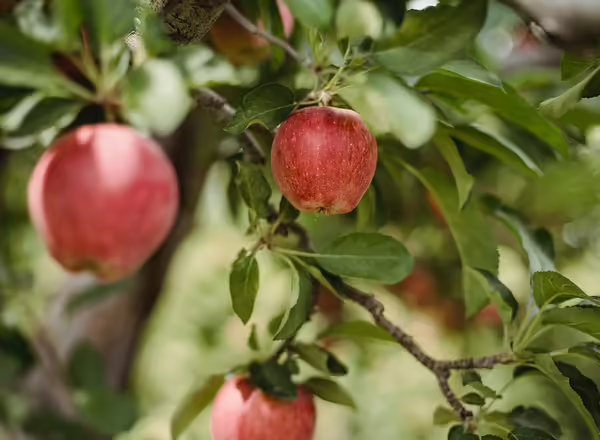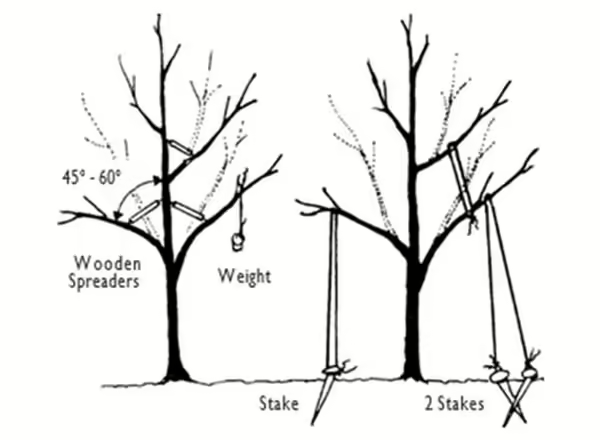Preventing Competition from Grass and Weeds
Young fruit trees have difficulty competing with grass and weeds for water and nutrients. An area extending 2 feet in all directions from the trunk of the tree should be kept cultivated or mulched in order to eliminate grass and weeds. Fertilizing will not eliminate the need for cultivating or mulching.
The use of mulch offers practical advantages for the home fruit grower. The mulch eliminates some cultivation, conserves moisture, reduces temperature fluctuation in the soil, and adds organic matter. Hay, straw, sawdust, wood shavings, and corncobs are good mulch materials. The mulch should extend as far as the limbs extend and should be 6 to 8 inches deep.
Mulch materials tie up nitrogen in the soil. Fertilization rates should be increased 50 percent when using mulch.
Mulches may harbor mice and voles that damage fruit trees by eating the bark at or just below the ground line. In the early fall, pull the mulch material away from the trunk and bait or trap the mice. Continue mouse control throughout the fall and winter.

Keep all fruits off the young trees during the first two growing seasons in the home orchard. Fruit removal encourages shoot growth and facilitates training. After two seasons’ growth, trees may be allowed to bear light to moderate crops. To prevent limb breakage and distortion of the tree shape, thin out heavy crops by increasing the space between fruits.
Special care must be given to the central leader (main trunk) of dwarf apple trees. This serves to avoid bending the central leader out of shape. If a fruit load bends the central leader, the leader will become a lateral fruiting branch, and the central leader will be lost.

Usually no special treatments are necessary to initiate bearing. Vigorous growth, however, sometimes delays bearing, especially of ‘Red Delicious’ apples. The onset of bearing can be encouraged by reducing growth. If a young tree is slow to start bearing, do not fertilize. Some trees may need special treatment to induce bearing. One way is to tie the branches into a partially horizontal position. Changing the branches
from a vertical (or upright) position to more horizontal position slows down growth and encourages the development of fruit buds. Tie the branches at a 45 degree angle, not into a completely horizontal position, or use branch spreaders (Figure N-9). Keep the branches spread until they set a crop of fruits. This may require more than one season because the fruit buds are initiated during the summer and bloom the following spring. The ideal time to spread branches is in early spring after pruning, but they may be spread at any time.

When tying branches, loop the twine over the branch and tie both ends to the stake. Do not wrap the twine around the branch. Scoring is another method of attempting to initiate bearing in apple trees that are slow in coming into bearing and are at least 5 years old. This is a dangerous treatment, however, and should be used only when the methods discussed above fail. About 3 to 5 weeks after apple bloom, cut through the bark (including the inner bark) with a sharp knife, making a circle on the trunk just below the lowest branch. Do not score other types of fruit trees.
Care of Bearing Trees
Because of variations in soil and climate through- out Illinois, the home gardener must adjust fertilization to local conditions. Dark-colored prairie soils in many areas of Illinois may provide adequate amounts of nitrogen, phosphorus and potassium for fruit trees.
- Apples, plums, apricots and cherries need 1⁄5 to 1⁄2 pounds of mixed fertilizer (such as 10-10-10 or equivalant) per year of age of tree, depending on shoot growth; maximum 10 pounds per tree.
Shoot growth on healthy trees
|
Fruit tree
|
Average shoot growth for young trees up to 6 years |
Average shoot growth for bearing trees over 6 years |
|---|---|---|
| Apple, dwarf and semi-dwarf | 10" to 20 " | 4" to 8" |
| Apple, standard and spur types | 10" to 20" | 6" to 10" |
| Peach, Nectarine, and Apricot | 10" to 24" | 8" to 15" |
| Sour Cherry and Plum | 10" to 20" | 8" to 12" |
- Peaches and nectarines need 1⁄2 to 1 pound of mixed fertilizer (such as 10-10-10 or equivalent) per year of age of tree, depending on shoot growth (Table N-3.); maximum, 10 pounds per tree.
- Pears frequently do best without fertilizer because of the danger of fireblight disease. Fertilization should be limited to 1⁄5 pound of mixed fertilizer (such as 10- 10-10 or equivalent) per year of age of tree with a maximum of 4 pounds per tree.
Lawn fertilizer (such as 10-6-4 or 10-8-6 or equivalent) is satisfactory. Use half as much of a 21-7-7 or similar lawn fertilizer. If the soil has adequate levels of phosphate and potash, ammonium nitrate (33-0-0) can be substituted for mixed fertilizer. Use one-third of the amount suggested for 10-10-10.
- Fertilize in early spring as the buds begin to swell.
- Broadcast the fertilizer in a circular band starting about 1 foot from the trunk and extending out to the spread of the branches.
Heavy pruning during the dormant (winter) sea- son produces the same effect on fruit trees as applying nitrogen. When a tree is pruned heavily, reduce or omit fertilization.
A grass cover in the home orchard is convenient and satisfactory for bearing trees. A mulch under bearing trees in combination with grass reduces the area to be mowed.
Keep the grass mowed as closely as a lawn. Native or wild grasses are satisfactory, or bluegrass or a blue grass-white clover mixture may be used.